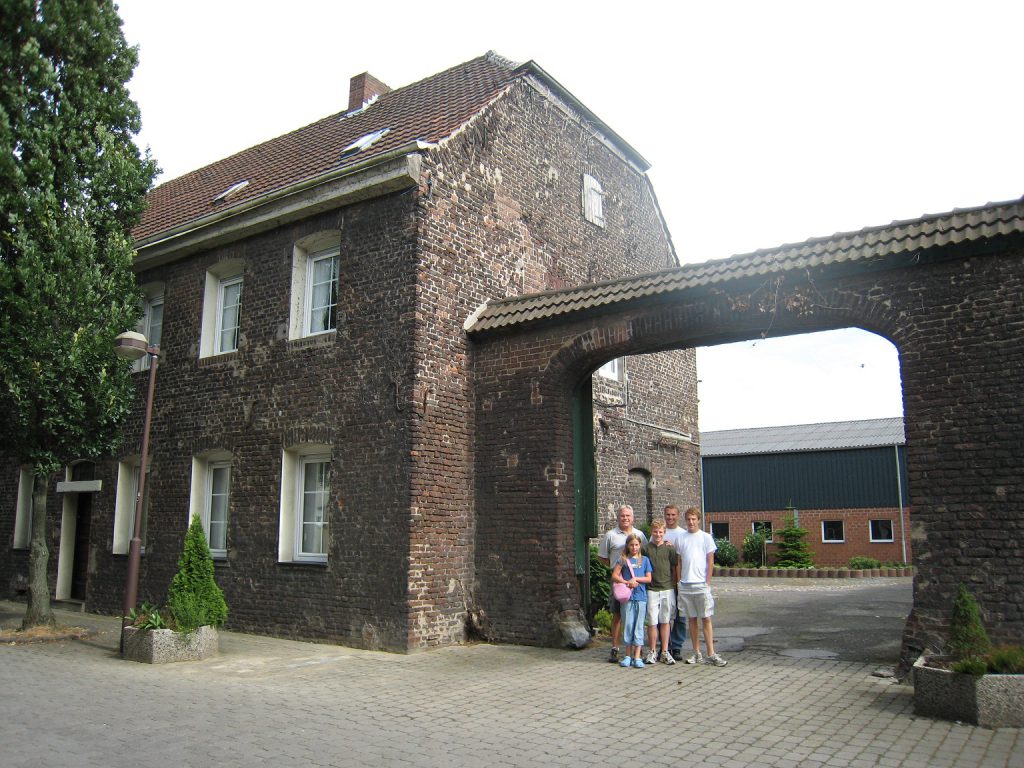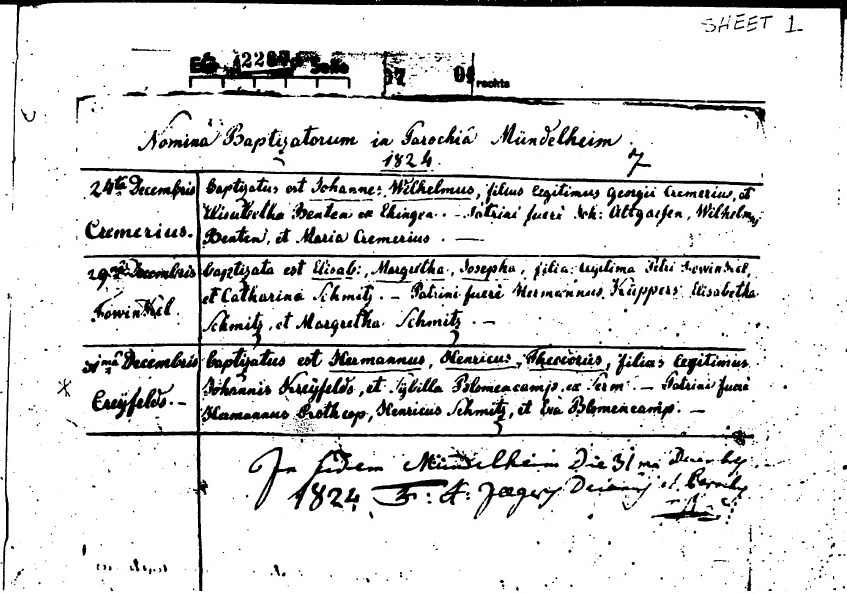Elizabeth Helen (Kreifels) Rademacher‘s grandfather was Herman Kreifels. Herman was the youngest of seven children born to a farming family in Serm, Germany. Serm is a little farm community on the banks of the Rhine River, just north of Düsseldorf. It’s right across the river from the city of Krefeld and that is probably the origin and meaning of the name “Kreifels”.
The spelling of the Kreifels name has had many variants over time. It’s been complicated by the fact that the letters “C” and “K” were interchangeable at the writer’s option back in Germany. Same for the letter pairs V/F, D/T and Y/I. So you can imagine all the variations for this name! Herman’s baptism record has the name spelled as “Creyvelds”. This makes it really hard to find Kreifels family records back in Germany (well, hard for me at least!).
Here is a copy of Herman’s baptism record from the Mündelheim Church near Serm. He’s the third one on the list. As you can see, the records were kept in Latin. His full name, Herman Heinrich Theodore Kreifels, was spelled in the record as “Hermannus Henricus Theodorius Creyfelds”.
We visited Serm and Mündelheim in 2007. Here’s a photo of Dale and the kids standing near some very old farm buildings in Serm, and then a photo of the interior of the Mündelheim Church where Herman was baptized.

Just like for the Blommer family, life was hard for the Kreifels family in Germany in the early 1800’s. Food was often scarce and young men were often at risk for being conscripted into the army. Refer back to the introductory post for the Blommer family and watch the “Germans to America” video segment for a taste of what conditions were like in the Rhine valley back then.
Herman’s mother died in 1836 and his father died in 1838, leaving him an orphan at the age of only 13. It was said that he was left pretty much to his own devices at that point. However, he remained close to his older brother Sebastian, who was five years older than Herman, throughout his life so I suspect that the two teenage brothers probably helped each other out in the years after their parents died.
At the age of 21, he somehow managed to come to America. He may have had contacts with other Rhine valley emigrants to the United States and they may have helped pay his passage in exchange for labor upon his arrival. He ended up in Loose Creek, Missouri where the Blommer family and many other Rheinlander Germans had settled about six years earlier. (Note on the map [above] the small town of “Osterath” in the bottom left corner. That’s where the Blommer family came from.)
In 1850, four years later, Herman’s brother Sebastian arrived in Loose Creek too.
I think there is much to be learned about Herman’s and Sebastian’s time in Missouri. I believe that they may have owned land and Herman may have held a minor elected office. I have not been able to find them in the 1850 census records but my search has not been exhaustive. Much more research to be done!
In 1852,Herman married Anna Margartha Blommer, the youngest daughter of the Mathias and Elizabeth Blommer. Sebastian then married Anna Gertrude Blommer, Anna Margaretha’s next older sister. The tabulation of early marriage records for Osage County, Missouri again highlights the problems with spelling of German names in the 19th century:

In 1855, the entire Blommer and Kreifels clan left Missouri and moved to Minnesota. Mathias Blommer mentions in his letters that life in Missouri was “unhealthy”, and I believe he means that literally – that disease was constantly present. The trip took seven weeks and probably involved moving household goods and livestock in a wagon train.
By then Herman and Anna Margaretha had two children, the youngest a tiny baby. Can you imagine dealing with dirty diapers while traveling cross-country by wagon?
Next time, more about life in Minnesota!



Thank you again Karen, really enjoy all of this history.